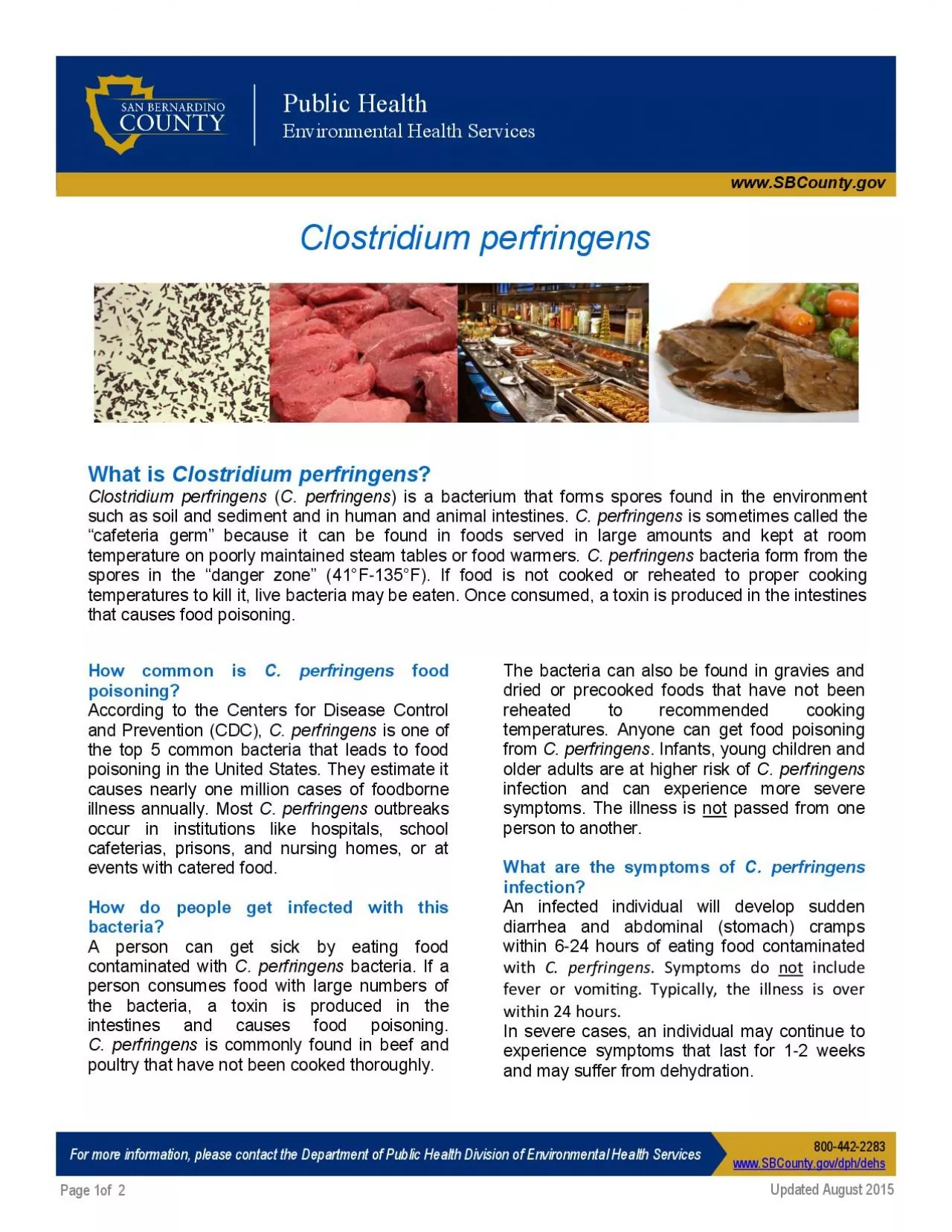

For more information please contact the Department of Public Health Division of Environmental Health Services 800 442 2283 wwwSBCountygovdphdehs Page 1of 2 wwwBSBFountyBgov Public Health Env ID: 938626
Download Pdf The PPT/PDF document "Updated August 2015" is the property of its rightful owner. Permission is granted to download and print the materials on this web site for personal, non-commercial use only, and to display it on your personal computer provided you do not modify the materials and that you retain all copyright notices contained in the materials. By downloading content from our website, you accept the terms of this agreement.
Updated August 2015 For more information, please contact the Department of Public Health Division of Environmental Health Services 800 - 442 - 2283 www.SBCounty.gov/dph/dehs Page 1of 2 wwwBSBFountyBgov Public Health Environmental Health Services What is Flostridium perfringens ? Flostridium perfringens ( FB perfringens ) is a bacterium that forms spores found in the environment such as soil and sediment and in human and animal intestinesB FB perfringens is sometimes called the temperature on poorly maintained steam tables or food warmersB FB perfringens bacteria form from the spores in the “danger zone” (41°F - 13D°F)B Hf food is not cooked or reheated to proper cooking temperatures to kill it, live bacteria may be eatenB Once consumed, a toxin is produced in the intestines that causes food poisoningB dried or precooked foods that have not been reheated to recommended cooking temperaturesB Anyone can get food poisoning from FB perfringens B Hnfants, young children and older adults are at higher risk of FB perfringens infection and can experience more severe symptomsB The illness is not passed from one person to anotherB What are the symptoms of FB perfringens infection? An infected individual will develop sudden diarrhea and abdominal (stomach) cramps within 6 - 24 hours of eating food contaminated with C. perfringens . Symptoms do not include fever or vomi�ng. Typically, the illness is over within 24 hours. Hn severe cases, an individual may continue to experience symptoms that last for 1 - 2 weeks and may suffer from dehydrationB How common is FB perfringens food poisoning? According to the Fenters for Disease Fontrol and Prevention (FDF), FB perfringens is one of poisoning in the United StatesB They estimate it causes nearly one million cases of foodborne illness annuallyB Most FB perfringens outbreaks occur in institutions like hospitals, school cafeterias, prisons, and nursing homes, or at events with catered foodB How do people get infected with this bacteria? contaminated with FB perfringens bacteriaB Hf a person consumes food with large numbers of the bacteria, a toxin is produced in the intestines and causes food poisoningB FB perfringens is commonly found in beef and poultry that have not been cooked thoroughlyB Updated August 2015 For more information, please contact the Department of Public Health Division of Environmental Health Services 800 - 442 - 2283 www.SBCounty.gov/dph/dehs Page 2 of 2 Clostridium perfringens A few deaths have been reported from dehydration which usually occur among infants, young
children, older adults, and individuals with other illnesses or health complicationsB How is FB perfringens infection diagnosed? Laboratory tests can diagnose FB perfringens food poisoning by looking for a type of bacterial toxin in feces (poop) or by tests to determine the number of bacteria in the fecesB Hn order to diagnose the infection, a count of at least 10 million FB perfringens spores per gram of feces within 48 hours of when illness began is requiredB How can FB perfringens food poisoning be treated? FB perfringens infections usually end within 24 hours and often do not require treatment other than drinking lots of fluids and getting restB Hn cases where a person is experiencing dehydration, intravenous fluids and electrolyte replacement can be used as a prevention or treatmentB Antibiotics are not needed or recommendedB What can be done to prevent FB perfringens food poisoning? To prevent the possibility of FB perfringens spores growing in food after cooking, foods such as beef, poultry, gravies, and other foods commonly associated with FB perfringens infections should be cooked thoroughly to recommended cooking temperaturesB These temperatures prevent the growth of FB perfringens bacteria that might have survived the initial cooking processB Since FB perfringens is usually found in beef and poultry, meat dishes should be served hot immediately after cookingB Leftover foods should be refrigerated at 41°F or below as soon as possible and within two hours of preparationB Hot foods can be put directly into the refrigeratorB Large pots of food like soup or stew or large cuts of meats like roasts or whole poultry should be divided into small portions for refrigerationB Once cooled to 41°F, foods should be covered to retain moisture and prevent them from contamination or picking up smells from other foodsB Leftovers should be reheated to at least 16D°F before servingB Foods that contain FB perfringens may not taste, smell, or look differentB Any food that has been left out for a long time may be dangerous to eat, even if it looks okayB Remember, when in doubt, throw it out! For more informa�on, please contact: County of San Bernardino Department of tublic Health Communicable Disease Sec�on www.sbcounty.gov/dph/publichealth (800) 722 - 4794 To report a possible foodborne illness, contact: County of San Bernardino Department of tublic Health Division of Environmental Health Services (800) 442 - 2283 Source: this information was taken from the Fenters for Disease Fontrol and Prevention’s website wwwBcdcBgov B